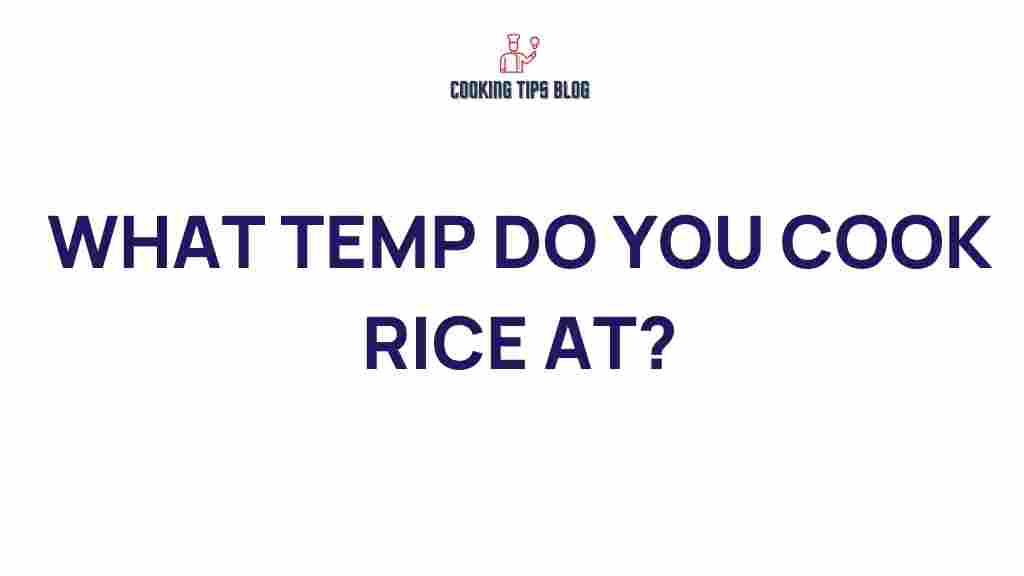Unveiling the Perfect Temperature: What Temp Do You Cook Rice At?
Cooking rice is a fundamental skill in many kitchens around the world. However, achieving the perfect texture and flavor depends significantly on the rice cooking temperature. Whether you’re a novice or an experienced cook, understanding the nuances of rice preparation can elevate your dishes. In this article, we will explore the ideal temperatures for cooking various types of rice, provide a step-by-step cooking guide, troubleshoot common rice cooking issues, and conclude with the best practices for perfect rice every time.
Understanding Rice Cooking Temperature
Rice cooking temperature is essential. Cooking rice at the right temperature affects not only the texture but also the taste. Generally, rice is cooked in a pot of water, and the temperature of the water plays a crucial role in how the rice cooks. Here are some key points to remember:
- Most rice varieties should be cooked at a simmer, which is approximately 190°F to 205°F (88°C to 96°C).
- Brown rice requires a slightly higher temperature for a longer duration to soften the husk.
- Some types of rice, like sushi rice, may require specific temperature adjustments for optimal texture.
Types of Rice and Their Ideal Cooking Temperatures
Different types of rice have varying cooking requirements. Here’s a quick guide:
- White Rice: Cook at a simmer (around 205°F or 96°C) for about 18-20 minutes.
- Brown Rice: Cook at a slightly higher temperature (around 210°F or 99°C) for 40-50 minutes.
- Sushi Rice: Start with a high temperature to bring water to a boil, then reduce to a simmer (about 200°F or 93°C) for 20 minutes.
- Jasmine Rice: Cook at a simmer (around 205°F or 96°C) for 15-20 minutes.
- Basmati Rice: Soak before cooking, then simmer at about 200°F (93°C) for 15 minutes.
Step-by-Step Guide to Cooking Perfect Rice
Now that we understand the importance of rice cooking temperature, let’s dive into a step-by-step guide for cooking perfect rice.
Ingredients Needed
- 1 cup of your chosen rice
- Water (usually 1.5 to 2 cups, depending on the rice type)
- Salt (optional)
- Butter or oil (optional)
Instructions
- Measure the Rice: Use a measuring cup to ensure accuracy. One cup of rice typically serves about 2-3 people.
- Wash the Rice: Rinse the rice under cold water to remove excess starch. This helps prevent the rice from becoming gummy.
- Measure the Water: The water-to-rice ratio varies. For white rice, use 1.5 to 2 cups of water; for brown rice, use 2 to 2.5 cups.
- Bring to a Boil: In a pot, combine the rice and water. Bring the mixture to a rapid boil over high heat.
- Simmer: Once boiling, reduce the heat to low, cover the pot, and let it simmer. Maintain a temperature of around 190°F to 205°F (88°C to 96°C).
- Check for Doneness: After the recommended cooking time, check if the rice is tender and all the water has been absorbed.
- Let it Rest: Remove the pot from heat and let it sit, covered, for an additional 10-15 minutes. This allows the rice to steam and become fluffy.
- Fluff and Serve: Use a fork to fluff the rice before serving. Enjoy your perfectly cooked rice!
Troubleshooting Common Rice Cooking Issues
Even with the best instructions, issues can arise. Here are some common problems and solutions related to rice cooking temperature:
1. Rice is Too Sticky
If your rice turns out sticky, it could be due to:
- Not rinsing the rice adequately.
- Using too much water.
- Cooking at too high a temperature.
Solution: Rinse the rice thoroughly and adjust the water ratio next time.
2. Rice is Undercooked
Undercooked rice can occur if:
- You didn’t cook it long enough.
- The temperature was too low.
Solution: Add a bit more water and continue cooking until the rice is tender.
3. Rice is Burnt at the Bottom
Burnt rice may result from:
- Cooking at too high of a temperature.
- Not using a heavy-bottomed pot.
Solution: Use a lower heat setting and ensure your pot is suitable for even cooking.
4. Rice is Too Dry
If your rice turns out dry:
- You might have used too little water.
- The cooking time may have been too long.
Solution: Adjust the water ratio for the next batch and monitor the cooking time closely.
Best Practices for Cooking Rice
To ensure you always cook rice perfectly, consider these best practices:
- Invest in a Good Pot: A heavy-bottomed pot distributes heat evenly, preventing burning.
- Use a Lid: Keeping the pot covered while cooking retains steam and moisture.
- Don’t Stir: Avoid stirring the rice while it cooks, as this can release starch and lead to stickiness.
- Experiment with Flavors: Add herbs, spices, or broth to the water for added flavor.
Conclusion
Understanding the correct rice cooking temperature is vital for achieving fluffy, delicious rice every time. By following the step-by-step guide provided, troubleshooting common issues, and adhering to best practices, you can master the art of rice cooking. For more cooking tips and tricks, check out our comprehensive cooking guide. And remember, practice makes perfect, so don’t be afraid to experiment with different rice types and cooking methods!
For additional information on rice types and cooking methods, visit this resource.
This article is in the category Tools and created by Cookingtipsblog Team
